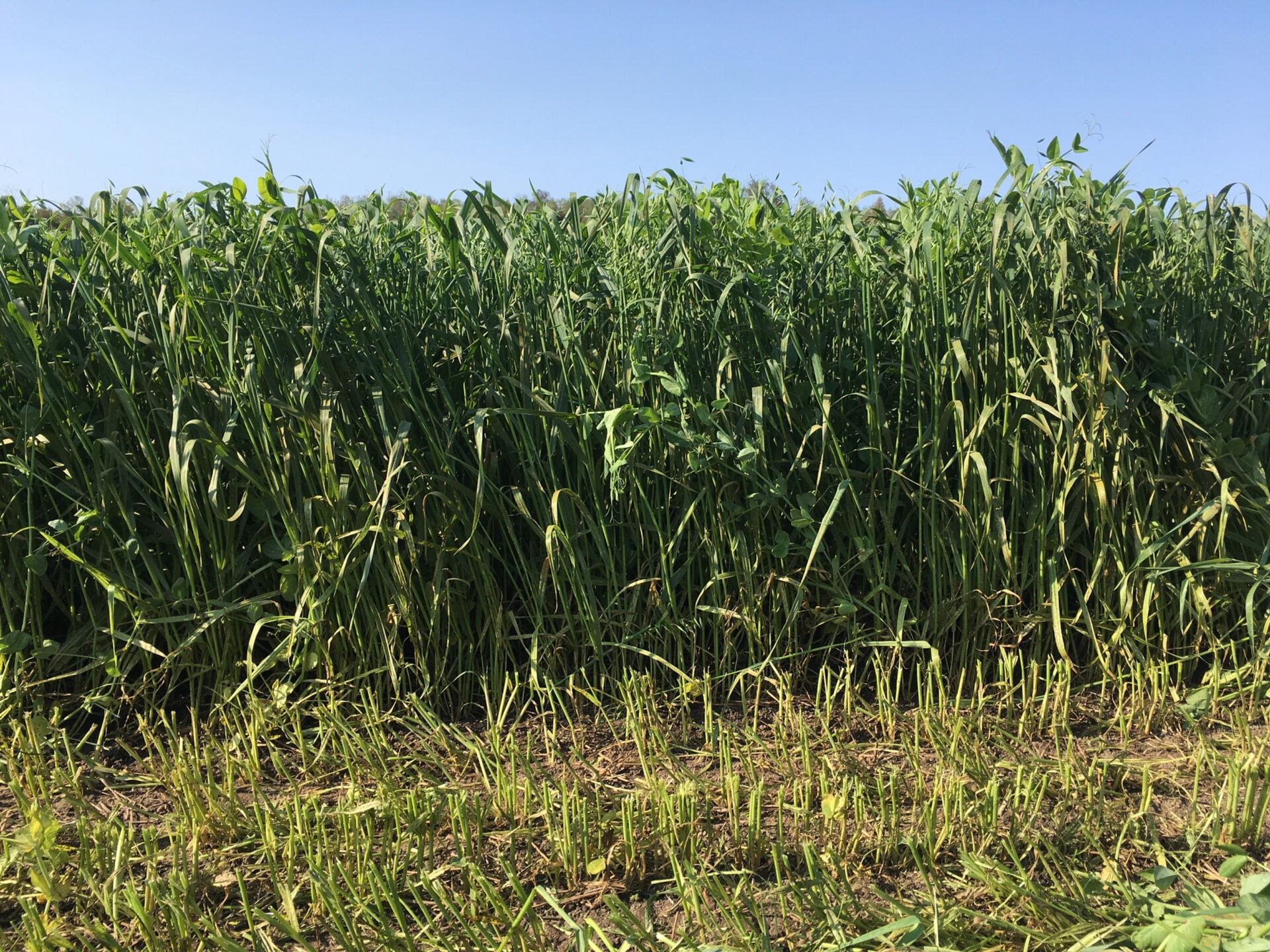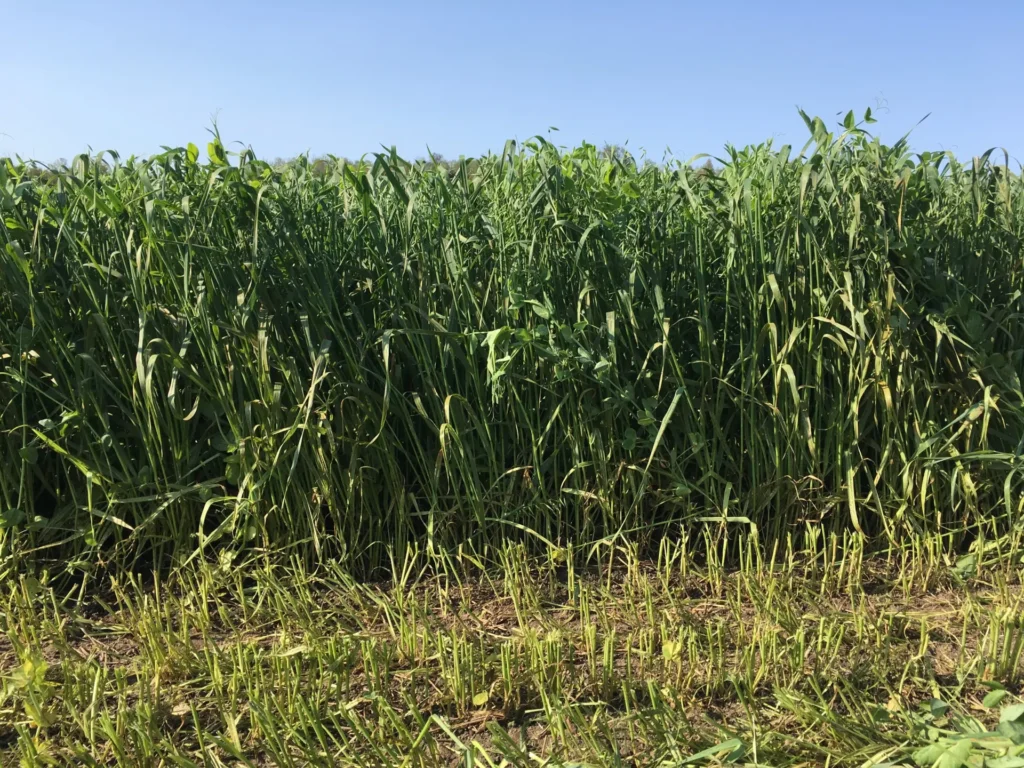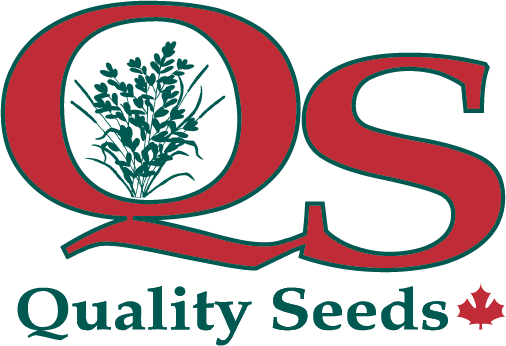Summer Seeding Oats & Oat-Pea Mixtures For Extra Forage

Summer Seeding Oats & Oat-Pea Mixtures For Extra Forage
by Joel Bagg, Forage Development Specialist & District Sales Manager, Quality Seeds Ltd
Summer seeding annual forages can be a useful low-cost option for producing extra feed, either as an emergency forage or a regular double-crop option. These forages include cool-season spring cereals (oats, barley, triticale) and cereal-pea mixtures, annual ryegrass / berseem clover mixtures, and QS “Evolution” Italian ryegrass, as well as the warm-season sorghum-sudangrass, sudangrass and millets (pearl, Japanese). But some of these options are potentially more successful than others.
Large acreages of emergency annual forages are often seeded in drought years, and can provide farmers with a “big save” in meeting their forage needs. Oats and oat-peas were the most successful in the 2012 drought. Potential baleage and silage yields are generally good, with good palatability and nutrient quality. An early winter wheat harvest provides a bigger window for timely summer seeding and earlier harvest of these forage crops.
Each option has its risks, advantages and disadvantages, and every situation is different depending on the immediate forage needs for this coming winter and forage quality requirements, as well as timing and rotation. Timely rains after seeding are needed for good growth and yields.
Oats have been frequently used, as a low cost, lower risk approach. Seeded in early-August following wheat and spring cereal harvest, they should be ready for harvest in early-October. Oats can make good feed when harvested at the correct stage of maturity and made into “oatlage” or baleage. Oats are more frost tolerant in the fall than sorghums, and can continue growth after some frost. The challenges can sometimes be lack of adequate moisture after seeding in August, and having dry enough weather in October for adequate wilting. Crown rust is also a potential risk. Rust can defoliate the oat crop and decimate yields if infection is severe. To avoid the risk of oat rust, some chose to use spring triticale instead. Oats can be strip-grazed if fence is available.
Oats, Barley, or Triticale?
Many find that oat forage is the most palatable of the cereals. Forage oats are often used. Oats tend to out-yield barley, spring triticale, and spring wheat when establishment conditions are poor, such as in hot, dry summer seedings. Some producers avoid barley and triticale in baleage because of concerns about the awns. At the same stage of maturity, oats, barley and spring triticale are very similar in feed quality. Of the cereals, oats are often the most readily available, and usually give the best yields and returns for the dollars invested.
Oat-Pea Mixtures
Forage peas can be added where higher forage quality is required to meet livestock needs. Cereal-pea mixtures are also popular as a spring seeded companion crop. Peas added to cereals improve forage quality, including crude protein and digestibility, but do not necessarily increase yields. Summer seeded peas dislike hot, dry conditions even more than cereals. Pea growth is often quite variable depending on moisture. Peas are more succulent and higher in moisture than oats, and can be very difficult to wilt in the fall. Pea mixtures may lie in the swath for an extended period of time with the risk of being rained-on. Lush cereal-pea mixtures can be difficult to cut. Pea seed costs more. Despite these issues, peas improve forage quality where meeting high nutritional requirements is a priority, such as for dairy cows.
A mix of 70% oats and 30% peas, is a good compromise for fall harvested forage, balancing improved forage quality with the increased challenges of harvesting peas in wet fall weather.
Oats Versus Sorghums or Millets During Late Summer?
Although sorghum-sudan and sudangrass are much more tolerant of hot dry summer weather than cereals, seeded in late summer, oats are a better choice. In situations where seeding dates are very early (July), allowing for harvest maturity (50 – 60 days) before cool weather and frost, sorghums will usually yield better than cereals. As cool-season grasses, oats are not very tolerant of hot dry weather and do not tiller and grow well in these conditions.
However, cereals planted after late-July may initially start slowly but they finish strongly in the fall, and usually perform better than sorghums. Warm-season grasses, such as sorghums, sorghum-sudans and millets do not grow well in cooler fall weather, and are very sensitive to frost. Once they are killed by that first frost, there is no further growth, which limits yield potential. Also after frost, there is a very narrow harvest window before forage quality drops significantly. There are also some concerns about potential prussic acid poisoning with frosted sorghums, particularly if pasturing. Oats will out-perform sorghums in cooler, wet fall weather, and are much more tolerant to hard frosts. They are not killed by frost until -9°C, enabling growth into very late fall, and a much wider harvest window.
Seeding
Oats normally require about 50 – 60 days of growth following germination to reach the boot-stage. However, summer seeded oats tend to mature more slowly as days shorten in the fall, so may require an additional 10 days, so about 60 – 70 days will be required. Oats seeded on August 1st would typically be ready to harvest in early-October.
Many prefer to no-till drill oats into wheat stubble to save time and soil moisture. Alternative seeding methods are to broadcast the oats and then incorporate them with a light disc or cultivator, or to seed into a prepared seedbed using a conventional drill. Summer seeded oats for forage are commonly seeded at about 70 – 100 lbs per acre. The suggested rate for oat-peas is usually 100 lbs/acre. Higher seeding rates have little impact on improving yields.
Seeding after winter wheat is harvested can be a good opportunity, but competition from volunteer wheat can occur. A lot of volunteer wheat can result when light grain goes through the combine, such as fusarium infection situations. Without vernalization (going through a winter) winter wheat will not form a stem in the fall to provide significant height of growth. Yields of the volunteer wheat are less than oats, but forage quality is excellent. Similar to preparing for an alfalfa-grass summer seeding, some do some light tillage (at least behind the combine swath) to encourage the grain to germinate, followed by a burndown with glyphosate 7 – 10 days later. However, this can delay seeding, resulting in a later harvest.
Fertility
Nitrogen (N) and sulphur )S) are essential for adequate growth and have a major impact on cereal forage yields and % crude protein. Apply at least 50 – 60 lbs/acre of actual nitrogen (N) at seeding or before tillering (3 weeks after germination. A suggested amount of sulphate is 1 lb for every 8 – 10 lbs of N. Manure can supply both N and S. Growth with inadequate nitrogen applied will be very disappointing.
Phosphorus (P) and potassium (K) will be removed in the forage. It is not essential to replace or add any P or K during the growth of an emergency forage crop, but the removal should be accounted for in the rotation. At current commercial fertilizer prices, the value of the P and K removed in the crop is typically in the 1.7 – 2.1 ¢/lb of dry matter range. This should be considered when pricing these crops.
Harvest Moisture & Fermentation
Wilting late-summer seeded oats to an acceptable moisture level to allow for a good fermentation during October weather can be challenging. Fall weather tends to be cooler, days are shorter, dews are heavy, and “rain delays” while lying in a swath can be significant, resulting in much slower and more difficult drying. Heavy crops and cereal-pea mixtures are especially challenging.
Generally, silage over 70% moisture and baleage over 55% moisture tends to be more prone to inefficient clostridial fermentations, especially if they were raked and soil was incorporated into the swath. This leads to high levels of butyric acid and “stinky, slimy” feed with reduced palatability and quality. Using a silage inoculant can help. Refer to “Silage Fermentation Problems” http://fieldcropnews.com/?p=5592.
In the severe drought year of 2012, farmers continued to harvest forage cereals and hay fields in late-October and into November, when weather suitable for wilting was almost non-existent. However with colder temperatures, spoilage was usually minimal if fed over the winter. When making baleage, apply adequate plastic wrap to ensure that it is kept anaerobic. As an alternative, strip grazing the growth in late-fall can be a good way to harvest late planted annual forage and avoid the challenges of making wet silage.
Yields Highly Variable
Yields of summer seeded cereals are highly variable, but under good conditions dry matter yields can typically be in the 1.25 – 1.75 tonne /acre range or more. In years of tight forage
supplies, every bit counts. Cereals can be a good low-cost emergency forage option if timely rainfall is received for germination and growth.
Forage Nutrient Quality
A common question is “what is the forage quality of these summer seeded forages?” This depends entirely on:
1. maturity at harvest, as well as
2. acceptable moisture levels for successful fermentation.
You can make this feed any quality you want if you cut earlier and are prepared to give up some yield. Cereals harvested at flag-leaf or boot-stage will be higher nutrient quality, but lower yielding than cereals harvested at late-head or soft-dough stage. When peas have been added to cereals, potential nutrient quality can be high.
Stage of maturity for optimum forage quality in many situations is at the “boot-stage” (head beginning to emerge from leaf whirl). Harvested at the boot-stage, fall grown oats are highly digestible and palatable. Quality is very high if harvested at the flag-leaf stage, but yields will be lower. With cooler temperatures and shorter days, fall grown oats often have higher digestible energy than spring seeded oats. Boot-stage oatlage is excellent feed for dairy heifers and beef cows, but may not be adequate to include in high producing dairy cow rations. At the boot-stage, cereals are typically about 16.5% crude protein and 54% NDF with very good fibre digestibility. Once headed, nutritional quality declines rapidly. Harvesting at the headed stage will provide more yield, but will have much lower digestible energy and protein. Use wet chemistry rather than NIRS laboratory analysis of cereal forage.
As with other grass species, there are sometimes a few reports of high nitrate levels, which can also result in silo gas. When this is a concern, testing for nitrates is recommended, particularly if this forage makes up a high percentage of the diet. Refer to “Potential Nitrate Poisoning” http://fieldcropnews.com/?p=4976.


Figure 2 – Summer seeded oat-pea mixture cut 50 days after planting.
Other Emergency Forage Options
Annual Ryegrass & Berseem Clover
These annual species are noted for fast establishment and early growth, provided that rainfall is not limiting. A suggested seeding rate is 20 – 22 lbs/acre. An 80/20 mix of Eco-Brand annual ryegrass and berseem clover is a good, inexpensive option. Nitrogen should be applied. Annual ryegrass will form a stem and a head the year of seeding, so it will provide more fall growth and yield than Italian ryegrass if feed is needed going into winter.
Italian Ryegrass
Summer seeded QS “Evolution” Italian ryegrass has exceptionally high forage quality (high NDFD, RFQ), palatability and intake suitable for high producing dairy cows. This is the highest quality forage option for fall harvested forage. Harvested in October and again next May, it provides a smaller yield of additional forage this fall (but extremely high quality), and a larger yield next spring. It can be followed by corn silage or soybeans, or it can continue to be harvested every 28 days the next year.
Winter Triticale or Fall Rye
Winter cereals, such as winter triticale and fall rye, are a good option if extra forage is needed next spring but not this fall. They are usually planted in September or early-October after corn silage or early soybeans are harvested. Winter triticale and fall rye grown for haylage can provide significant volumes of feed. The harvest window for the correct stage of maturity for high forage quality (flag-leaf) is narrow, particularly fall rye. Fall rye harvest will typically occur in mid-May. Triticale maturity is slower and about 7-10 days later, so it is more forgiving if wet weather delays harvest. Fall rye or winter triticale also provides a good opportunity to double crop forage by planting sudangrass in early-June. Good success has been experienced when underseeding alfalfa-grass to sudangrass. Refer to www.qualityseeds.ca/high-quality-winter-triticale-forage/.
Underseeded Red Clover
Wheat fields that had red clover underseeded as a cover crop are a good source of forage. Red clover makes excellent feed for high producing dairy cows. Refer to “Red Clover Haylage” http://fieldcropnews.com/?p=6605.
Drought Damaged Corn Silage
Damaged corn crops with low grain yield potential may be available for salvaging as corn silage. Quality will depend on grain content. Ensiling at the correct moisture is important, Refer to https://fieldcropnews.com/2012/07/drought-damaged-corn-silage/ .
